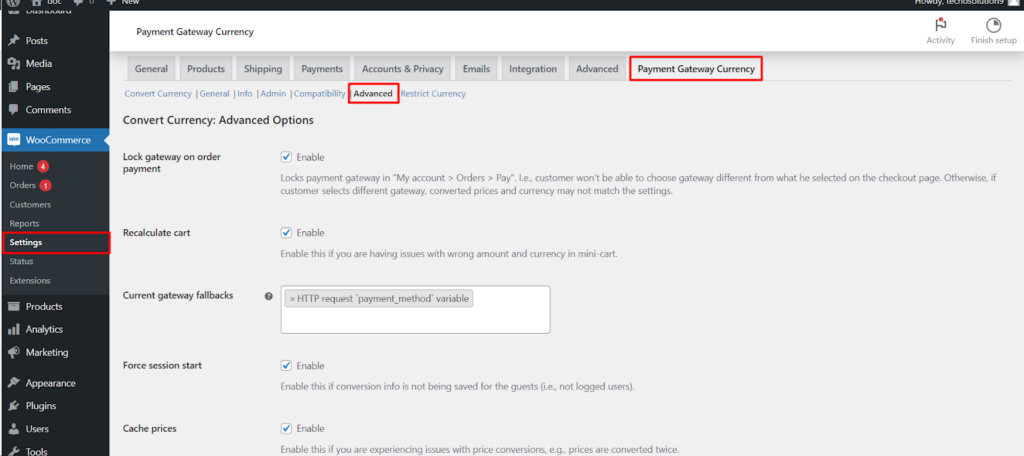The Convert Currency for WooCommerce plugin by WPFactory goes beyond the basics, offering a comprehensive set of Advanced Options within the Payment Gateway Currency section. This guide explores these settings, empowering you to fine-tune the plugin’s behavior and address potential conversion-related issues within your WooCommerce store.
Ensuring Payment Gateway Consistency
- Lock Gateway on Order Payment: Enable this option to prevent customers from changing their chosen payment gateway during the “Pay” section of their account page when viewing order details. This helps maintain consistency in currency conversions, as changing gateways might affect displayed prices.
Troubleshooting Conversion Issues
- Recalculate Cart (Optional): If you’re encountering incorrect amounts and currencies within the mini-cart, activating this option might resolve the issue.
- Current Gateway Fallbacks: This section defines how the plugin determines the payment gateway to use for currency conversion if the customer’s originally chosen gateway is unavailable.
Here are the available options
- (Deselected) HTTP request payment_method variable: This option is not recommended by the plugin.
- First Available Payment Gateway: The plugin will use the first available payment gateway on your store.
- Last Known Payment Gateway: The plugin will attempt to utilize the last payment gateway the customer used.
- Default Payment Gateway: The plugin will fall back to your store’s default payment gateway.
- Force Session Start: Enable this option if you’re experiencing issues with conversion information not being saved for guest users (non-logged-in customers). This ensures session data is created, allowing the plugin to store conversion details.
- Cache Prices (Optional): If you’re facing problems with price conversions, such as prices being converted twice, activating this option might help. The plugin will then cache converted prices for improved efficiency.
Select the appropriate caching level
- Product ID: Cache prices based solely on product IDs.
- Product ID and product data: Cache prices based on product IDs and additional product data.
- Product ID and product changes: Cache prices based on product IDs and update the cache whenever product data changes.
- Fix RTL Currencies: Enable this option if you’re encountering issues with right-to-left (RTL) currency symbols displaying incorrectly. This ensures proper alignment for currencies used in languages written right-to-left.
- Rate Step (Optional): By default, the plugin uses a specific step value when handling exchange rates. If you prefer, you can enter “text” here to define the exchange rate as text instead of a number, bypassing the step value. Use this option with caution and ensure the entered text format aligns with your currency exchange provider.
Debugging and Resetting
- Debug: Enable this option to generate additional logs related to the Convert Currency plugin within the WooCommerce > Status > Logs section. This can be helpful for troubleshooting potential conversion-related issues.
- Reset Settings: If you need to revert to the plugin’s default settings or encounter any configuration issues, you can utilize this button to reset the entire Advanced Options section.
Conclusion
The Advanced Options within the Convert Currency for WooCommerce plugin empower you to fine-tune the plugin’s behavior, address potential conversion inconsistencies, and ensure a smooth currency conversion experience for your store. By understanding these settings and applying them strategically, you can optimize your store’s functionality and enhance customer satisfaction.
